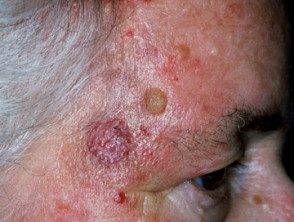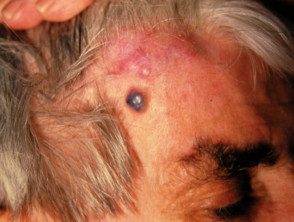What is an angiosarcoma?
Angiosarcoma is a rare and aggressive disorder. evil one tumor (Cancer) that arises from endothelial cells, which normally line the walls of blood or lymphatic glasses
- Hemangiosarcomas begin in blood vessel walls
- Lymphangiosarcomas begin on the walls of the lymphatic vessels.
Angiosarcomas can occur in any organ of the body, but are most often found on the skin and Soft fabric. They can also originate in the liver, breasts, spleen, bones, or heart.
After having been surgically removed, angiosarcomas:
- Often repeated locally
- Systemic spread, with a high rate of lymph node metastasis
- Have a poor forecast and a high mortality rate.
Angiosarcoma


Who gets angiosarcoma?
Angiosarcoma is twice as common in men as in women. Angiosarcoma of the head and neck mainly affects older people.
The tumor may develop as a complication of a pre-existing condition. Certain groups of patients may be at increased risk of developing angiosarcomas. These include:
- Patients with chronic lymphedema (a buildup of lymph fluid in the arms) who underwent a radical mastectomy for breast cancer (removal of the breast and all lymph nodes under the arm)
- Radiotherapy patients (especially those who have been exposed to the Thorotrast radiation-emitting contrast agent; this agent is no longer used, but angiosarcomas have occurred in people decades after exposure)
- Patients with foreign material (such as Dacron, shrapnel, steel, and plastic) in the body.
- Patients exposed to environmental agents such as aerosols containing arsenic and vinyl chloride used in the plastics industry.
What causes angiosarcoma?
The cause of the fast proliferation and infiltration of malignant endothelial cells in angiosarcoma is generally unknown.
What are the signs and symptoms of angiosarcoma?
The signs and symptoms of angiosarcoma differ depending on the location of the tumor. Often, the symptoms of the disease are not apparent until the tumor has become more advanced.
Soft tissue symptoms include:
- Rapidly growing tumor of the limbs or abdomen.
- Abdominal tumors can grow to large sizes before they are detected since the abdomen can accommodate tumors
- Hemorrhage, anemia, hematomaand gastrointestinal bleeding
- Enlarged adjacent lymph nodes
Symptoms present on the skin include:
- Enlarged bruise, a blue-black noduleor uncured ulceration
- The injuries can bleed and be painful.
- Angiosarcomas that occur in the head and neck in older people are one of the most common forms of cutaneous angiosarcoma
Angiosarcoma can also affect the bones as well.
- Tumors can grow in multiple bones in the same limb.
- Pain and tenderness in the affected area are common.
- There may be swelling and enlargement of the affected limb.
Angiosarcoma in the breast presents as a palpable dough without tenderness. Tumors often grow deep within the breast tissue, causing diffuse enlarged breasts with associated bluish skin discoloration.
Hepatic The symptoms of angiosarcoma can vary and are not specific, and can include fatigue, weight loss, and pain in the right upper quadrant. Angiosarcoma in the lungs can cause bloody chest pain sputum, weight loss, cough and shortness of breath
Cutaneous angiosarcoma
Cutaneous angiosarcoma is the most common form of angiosarcoma not associated with chronic lymphedema. The disease is located mainly in the head and neck of older people and is also known as Wilson-Jones angiosarcoma, senile angiosarcoma, or malignant angioendothelioma.
The clinical features of this form of angiosarcoma are lesions, which appear most frequently on the scalp or upper forehead.
- In the early stages of the disease, the lesions may be singular or multifocal, bright red or dark slow-spreading patches, somewhat like a poorly defined hematoma.
- Injuries can become high nodules or plates It can bleed and ulcerate.
- Lesions grow rapidly and spread, making margins difficult to define.
What is the treatment of angiosarcoma?
The treatment of angiosarcoma is dependent on the location of angiosarcoma and the extent of the tumor. Treatment includes chemotherapy, surgery, radiotherapy or a combination of these treatment modalities.
The optimal treatment of cutaneous angiosarcoma has not been defined. These angiosarcomas are difficult to treat due to their multifocal nature and extensive spread pattern. Radical surgery and postoperative radiation therapy are generally used but the tumor reappearance It is common after treatment. Despite aggressive treatment, the prognosis is often poor.
Paclitaxel is a powerful antiangiogenic drug that shows promise in the treatment of angiosarcoma when administered weekly.
